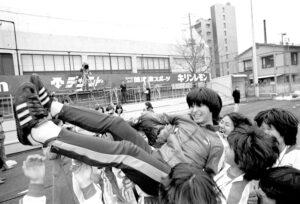“History of the Nadeshiko League” 2. “Girls’ and Women’s Football in Japan”
From the time when it was still unusual for women to play football, through to the birth of the Japan Women’s Football League, victory in the Women’s World Cup, and creation of the Japan Women’s Empowerment Professional Football League, social conditions and the environment surrounding girls’ and women’s football have undergone great changes.
We intend to publish a series of 22 articles before the end of the year in which we will look back over the tempestuous history of girls’ and women’s football in Japan.

Somebody once said, “There was no football in Japan until the J League”. Of course, that is a great misconception. In the same way, women’s football in Japan did not suddenly begin with the launch of the Japan Ladies Soccer League (the current Nadeshiko League) in 1989. There was a long history before that.
It is well known that two teams formed in Hyogo Prefecture in 1966 were the first women’s football teams in Japan. One was “Fukuzumi Girls’ Soccer Sports Group”, which comprised 26 sixth-grade girls of Fukuzumi Elementary School in Nada district, Kobe, and the other was a team comprising 15 third-grade students of Kobe College Junior High School in Nishinomiya.
These two teams played each other at Oji Stadium situated near to Fukuzumi Elementary School in Nada district, Kobe on March 19, 1967. This is the oldest known game between female football teams in Japan. The referee and two assistant referees (referred to as “linesmen” at that time) were also women.
However, that was not the beginning of women’s football in Japan. Recently discovered materials indicating that women were playing soccer in various parts of Japan during the Taisho Era (1912-1926) roughly 100 years ago are attracting attention.
The Taisho Era was a period when women engaged in more and more occupations and Japanese women, who until then had been tied down in the home, started to make advances into society. In line with this, there was also a campaign calling for the enhanced social status of women. The growing desire of women to “no longer be outdone by men” also exerted an impact on sports.
In elementary schools, girls started to play football together with boys. Some “girls’ schools” (equivalent to today’s junior high schools and senior high schools) introduced soccer into their physical education lessons. This was an age in which social advancement and hopes for the future invigorated girls and women like they had never experienced before.
However, as Japan moved into the Showa Era and went to war, this social atmosphere disappeared. After the country emerged from the post-war confusion, women started to feel that they wanted to enjoy football like men, and it was the period from the 1960s to the 1970s, when the “women’s liberation” feminist movement was happening around the world, that these feelings were translated into action.
In the 1970s, a succession of girls’ and women’s teams were founded and lots of games came to be played in the Kanto and Kansai areas. At that time, almost all males thought, “Football isn’t a game for girls” and female players were viewed with curiosity, however, they practiced hard and grew in numbers while playing in various games.
In 1979, the Japan Football Association started to accept registrations of girls’ and women’s teams. This may come as a surprise, but in more than 50 years after its founding, the Japan Football Association was “an organization intended only for boys’ and men’s football”. In the first year, 52 girls’ and women’s teams and a combined total of 919 players were registered.
At the end of that business year, in March 1980, the first JFA Japan Women’s Football Championship (Empress’s Cup) was held. Even then, although girls’ and women’s players and teams had registered with the Japan Football Association, their activities could not be supported by the JFA, but rather an organization called the “Japan Women’s Football Federation” had to raise its own funds.
Together with the launch of the JFA Japan Women’s Football Championship, the number of girls’ and women’s teams increased rapidly. Ten years later, in 1989, the Japan Women’s Football Federation was developmentally dissolved, paving the way for the Japan Football Association to take full responsibility for the women’s game. Although registrations had begun in 1979, they were only a formality, and it wasn’t until 10 years later that girls and women truly became “members of Japan’s football community”.
This was the year that the Japan Ladies Soccer League, today’s Nadeshiko League, was launched.
Yoshiyuki Osumi (football journalist)






